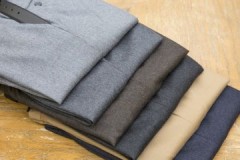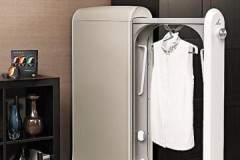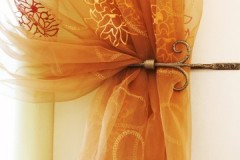A difficult procedure, or how to iron curtains correctly and quickly
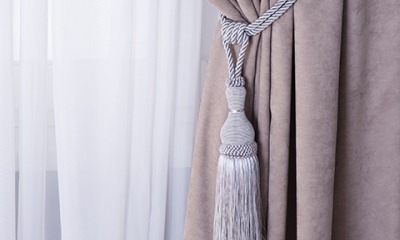 Curtains are an element of decoration of most living quarters. They play a functional and aesthetic role.
Curtains are an element of decoration of most living quarters. They play a functional and aesthetic role.
Caring for many types of curtains involves both washing and ironing.
It is quite possible to smooth out such a voluminous interior element at home if you act systematically and adhere to the recommendations of experts. How to iron curtains made of various materials - read below.
Content
Do you need ironing after washing?
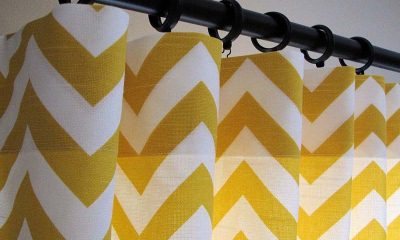 The choice of ironing option depends on a number of circumstances:
The choice of ironing option depends on a number of circumstances:
- personal preferences;
- availability of special household appliances (steamer, iron);
- type of fabric;
- web length and width;
- the presence of decorative elements;
- cut features.
The determining factor is the composition of the fabric, which gives restrictions on the heating temperature and the method of action when smoothing.
Procedure
Ironing on an ironing board is the standard approach to flattening fabric.
Procedure:
- The ironing board is laid out directly under the window.
- Iron the top half of the linen.
- Hang the curtain on the cornice.
- Iron the lower half of the canvas without removing it from the cornice.
The seams are ironed only from the inside out and through the additional fabric.
How to smooth out a large curtain?
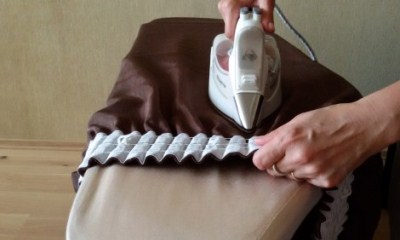 For large volumetric curtains, not even a standard ironing board can be used, but a larger flat surface, for example, a table. Or an option is possible with a wide long board, covered (or sheathed) with a dense fabric.
For large volumetric curtains, not even a standard ironing board can be used, but a larger flat surface, for example, a table. Or an option is possible with a wide long board, covered (or sheathed) with a dense fabric.
Iron the curtain normally start at the top... This raises a problem: how to prevent creasing of already ironed fabric? The freely descending matter can crumple even under its own weight.
To prevent this, it is recommended to use an additional tool - a round smooth stick at least 1 or 1.5 meters long. Such a pole will help to avoid creasing of an already ironed curtain.
Pushing the ironed fabric from the board, it is loosely wound on a round stick... After the entire length of the item has been ironed, it can be hung in place.
Steaming by weight without removing from the eaves
It is possible to iron curtains hanging directly on the eaves as a preventive measure and for cleaning, if steaming is used. This method is recommended for large volumetric curtains made of heavy material.
If there are no contraindications to the use of a steam generator and a steamer, then the minimum temperature regime is set, and the distances between the nozzle and the fabric are maintained. Processing is carried out systematically, by weight.
Steamers are:
- outdoor;
- manual.
| Steamer type | Characteristic |
| Manual | The manual version of the steamer is best suited for curtain models that are simple to cut. The disadvantage of the device is its low power and the need to use an extension cord. |
| Floor | Floor standing steamers are suitable for tricky draperies and a lot of creases. These are powerful devices that allow you to very quickly deal with folds in the material. |
Steaming can also be done with a regular iron, which has a vertical steam function.
In this case, the surface of the sole of the device should not touch the fabric. The impact will be carried out from a distance, without direct contact with the sole of the iron. The use of hot steam is prohibited on delicate and delicate fabrics.
Is it possible to do without an iron and a steamer
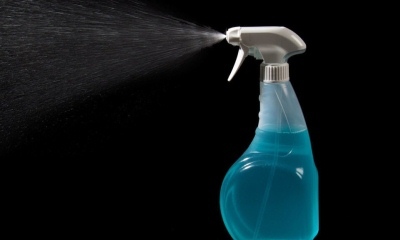 In the absence of special household appliances, homemade recipes will help to eliminate the crumpled places on the curtains.
In the absence of special household appliances, homemade recipes will help to eliminate the crumpled places on the curtains.
If the wrinkle is the result of improper drying and washing, then it is possible to correct the situation:
- repeated washing and proper drying;
- moistening the surface with a spray bottle with clean water;
- if the material allows - by spraying a special solution prepared from equal parts of vinegar, fabric softener and clean water.
The type of material dictates the rules
Each interior style dictates its own design rules. A large number of materials and design solutions allows you to choose the best version of the curtain model for each room:
| Type of material | Ironing features |
| Viscose or polyester | Curtains made of polyester and viscose do not attract dust, do not stretch during operation. They can be ironed at low temperatures - no more than 150 ° C. However, the steam function should not be used. The iron is moved carefully, without holding it in one place. |
| Cotton or linen | Natural linen and cotton products allow using high heating temperatures of the iron. In order to smooth the material, it must be slightly damp. If the curtain is already completely dry after washing, it must be moistened and ironed with steam. You can also iron through an additional damp cloth. |
| Organza or chiffon | After washing, such curtains can be immediately hung on the cornice when wet. But if the fabric is very wrinkled, then it can be smoothed through tissue paper at the lowest temperature. The use of the steaming function, as well as high temperatures, is prohibited - the material can deform and go in ugly waves. |
| Taffeta or silk | Ironing should be done from the inside out at a low temperature - up to 110 ° C. Do not use steam or moisten the material, as this can lead to stains and streaks. |
| Capron | Easy-care material allows you to do without ironing at all. If you hang a freshly washed curtain evenly, you can do without ironing. Temperature range - up to 110-150 ° C. |
| Veil | Iron delicate fabric only through additional fabric. The steam function is turned off. No effort is made during ironing. |
| Blackout | Thick opaque fabric after washing does not require ironing. If jammed spots appear, then they can be removed with a not very heated iron. |
| Velvet or velor | Fabrics with light short pile should not be ironed in the usual way. After washing, the curtain is wrung out through a terry towel and dried. You should iron velvet and velor very gently, turning the front side onto a spread terry towel. |
Except for curtains made of one kind of fabric, there are models made of a combination of materials, as well as double-sided.
For curtains on a lining, straightening must be performed for both the inner and outer sides, changing the heating modes of the iron and selecting suitable processing conditions.
Lambrequin: the most difficult element
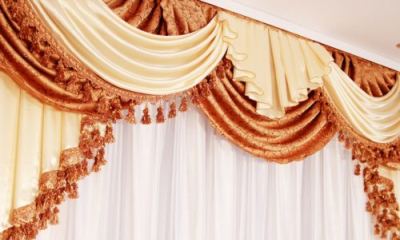 Lambrequin is an elegant decorative drapery that is attached at the top of the curtain composition... For the most part, such decoration of a window opening is made from the same fabric as the curtain.
Lambrequin is an elegant decorative drapery that is attached at the top of the curtain composition... For the most part, such decoration of a window opening is made from the same fabric as the curtain.
The shape of the lambrequin can be very different, most often - with a lot of folds.
Some lambrequins cannot be washed, they are cleaned by steaming or dry-cleaning.
The complex shape of the drapery is almost impossible to straighten with an iron... Steaming comes to the rescue.
Fabrics that do not need to be ironed
It is not possible to avoid ironing curtains in all cases. Some types of fabrics are not prone to self-expansion, and require mandatory heat treatment. But many materials can do without ironing, and still look decent.
Such materials include:
- chiffon;
- organza;
- blackout and some other types.
Correct washing will avoid ironing. To avoid ironing curtains, wash them only by hand.
The washing process should proceed as follows:
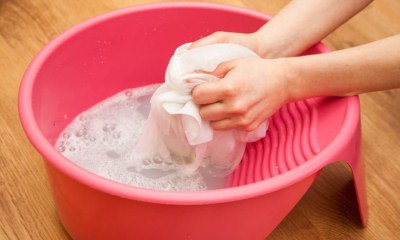 The curtains are removed from the cornice.
The curtains are removed from the cornice.- Warm water is drawn into the bath.
- Dilute a suitable detergent in water.
- The curtain is gently lowered into the water.
- If the fabric is organza, silk or chiffon, then wash the curtain immediately. For other materials, a short soaking is possible, for a quarter of an hour.
- They wash delicate fabrics without intense physical impact with stroking movements.
- Rinse several times in clean water (cool or slightly warm).
- The curtain is taken out of the bath without squeezing.
- Hang the curtain in a free state. At the same time, a container for draining water is substituted.
- Spread the fabric with your hands.
- After the water has drained, the curtains are still damp and re-hung to a permanent place.
Errors
In the absence of experience in ironing such large things as curtains, mistakes can be made. The most common are the following:
| Mistake | What can it lead to? | How to avoid? |
| Incorrectly set temperature on the iron. Steaming of fabrics for which this method of stretching is prohibited. | If the temperature is insufficient, the curtain fabric will not straighten, but will remain crumpled. If the temperature is set higher than the recommended one, the material may deform, lose its shape, etc. | The product label contains all the necessary information. It is necessary to study it before starting ironing. |
| Ironing directly on the front of the curtain. | Ugly prints on the front side, stains may appear. | Iron preferably through additional fabric or from the wrong side. |
| Use as an auxiliary additional fabric of colored fabric. | The fabric may shed and ruin the curtains. | As an additional fabric through which ironing is carried out, it is necessary to use a non-fading material, preferably cotton. |
| When ironing, the presence of decorative elements on the curtain is not taken into account. | Decor elements can deform, ruin the fabric of the curtain and the sole of the iron. | The decor on the curtains cannot be ironed from the front side without an auxiliary fabric. |
Useful video
How to quickly iron the curtains, the video will tell you:
Conclusion
Ironing curtains is not an easy procedure that has many features. When carrying out it, many factors must be taken into account. It is necessary to start acting by studying the label and determining the composition of the material.
If washing and steaming is prohibited, the curtains are dry-cleaned for cleaning and shaping.

